Microsoft Surface Pro 3 Review
by Anand Lal Shimpi on June 23, 2014 3:55 AM ESTThickness, Thermals and Core: Understanding how Surface Pro 3 Got so Thin
Ever since Surface RT showed up I've wanted Surface Pro but in the RT chassis. Microsoft seemed to consciously avoid any lower TDP Core processors in favor of Ultrabook SKUs, which pretty much kept Surface Pro thicker than its ARM-based counterpart. Surface Pro 3 changes everything with a rethinking of how Microsoft embraced the thermal constraints of a tablet.
Surface Pro 3 is available with one of three CPU options: a Core i3, Core i5 or Core i7. The latter two are 15W TDP parts, while the former is a 11.5W TDP/6W SDP Haswell Y SKU. Haswell Y is really designed for passively cooled form factors, but all three CPU options receive the same heatpipe and fan cooling system offered by the Surface Pro 3. In short, the Core i3 model should behave a lot more like a standard Ultrabook part (sans Turbo).

Surface Pro 2 (left) vs. Surface Pro 3 (right)

Apple iPad Air (left) vs. Surface Pro 3 (right)
Microsoft's claim to fame is the ability to build the world's thinnest device with a Core series CPU inside. At 9.1mm thick, the Surface Pro 3 is just barely thicker than last year's Surface 2 but with a full blown dual-core Haswell instead instead of a high-end phone/tablet ARM SoC. As both the Surface Pro 2 and Surface Pro 3 used 15W Haswell Ultrabook parts and Microsoft claims a performance increase over last year's model, the question is how Microsoft can reduce thickness, keep TDP the same and increase performance. The answer is simply a difference in what's acceptable from a thermal standpoint.
Here's a look at the original Surface Pro while running an hour long loop of 3DMark Ice Storm Unlimited. I chose this test in particular as it behaves as a nice balance between CPU and GPU workloads on the device:
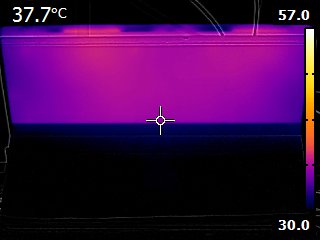
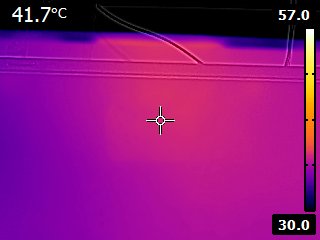
You can almost trace out the path of the heat pipe carrying the thermal load away from the CPU and to the two fans in the system. I measured peak temperature here at 41.7C.
Now let's look at Surface Pro 2:
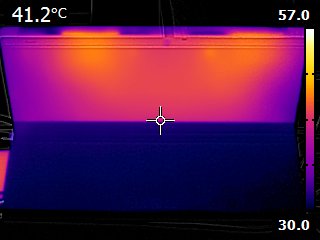
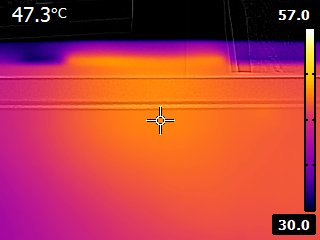
Despite a move to Haswell, Microsoft lets the device get much warmer. You can make out the same U-shape thermal distribution as heat is carried away using the two fans, but the temperatures are much higher. I measured a maximum temperature running the same workload of 47.3C.
Here we have Surface Pro 3:
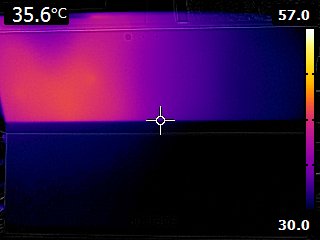
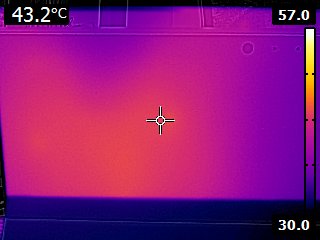
Right away you can see the new cooling system at work. The thermal load is mostly confined to the left side of the image (we are looking at the back with the kickstand unfolded towards the camera, so if you were looking at the display we're talking about the upper right side of the machine). The cooling solution is far more compact and I suspect ready for a move to Core M (Broadwell). Peak temps however are much closer to Surface Pro 1 at 43.2C.
The thermal story points us in the right direction. Either Surface Pro 3's fan and heatpipe configuration is able to remove heat far better than Surface Pro 2's design could, or the CPU in SP2 doesn't get as warm. I suspect it's the latter.
For starters, I'm guessing that Intel is helping Microsoft with delivering better binned Haswell ULT and Y series SKUs. But the big change is I believe Microsoft is more aggressive about reducing CPU and GPU frequencies in Surface Pro 3 compared to Surface Pro 2. Benchmarks will show an increase in performance due to more aggressive ramping up/down of clock speeds vs. Surface Pro 2, but prolonged load cases will likely show a decrease in performance vs. last year's model.
I first stumbled upon this behavior while trying to gather thermal data for Surface Pro 3. I noticed large run to run variance if I repeatedly ran 3DMark 11. I'm used to seeing this sort of behavior on smartphones that throttle quickly, but it was unique for a Surface Pro device.
3DMark is a synthetic test so the real question was how would Surface Pro 3 perform in a real world scenario where sustained CPU/GPU load was guaranteed for a long period of time. I figured a game playable on the machine like Dota 2 would be a great example. I asked our own Ryan Smith to whip up a custom benchmark using the game and I ran it on Surface Pro 1, 2, 3 as well as a 13-inch MacBook Air (Early 2014). The graph below illustrates average frame rate during our Dota 2 benchmark for all of the systems:
As you can see, even with Surface Pro 3's fan running the platform doesn't deliver sustained performance equal to last year's model. It's an understandable tradeoff given the substantial reduction in device thickness (and thus improvement in usability), but it's important to note nonetheless.
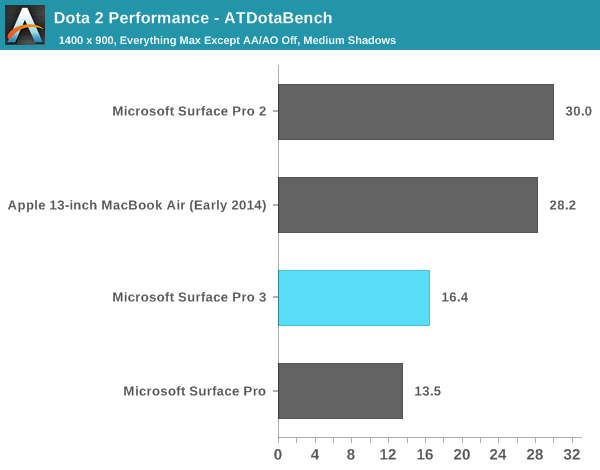
Workloads that are CPU and GPU heavy are one thing, but what about sustained productivity workloads? Penny Arcade's insanely talented artist Gabe mentioned that he noticed substantial lag when drawing on his Surface Pro 3. As Surface Pro 3's NTrig pen is actually lower latency than Surface Pro 2's, I wonder if what Gabe ran into might be thermal related rather than pen related (alternatively it could have to do with the much higher display resolution that Surface Pro 3 runs at). I needed a repeatable workload to see if non-gaming use cases also showed a regression. Thankfully PCMark 8 v2 provides a number of relatively long, repeatable workloads that are great for testing just this.
I decided to use the PCMark 8 v2 Work suite which includes web browsing, office producitivity (word processing and spreadsheet work) and video chat. It's a far cry from a Cinebench loop but I figured if I saw throttling here it would easily be present in heavier workloads. Each run of the suite actually repeats the tests three times and takes around 20 minutes to complete on the Surface devices. I measured performance for three suite runs (9 total runs of the Work loop) on both Surface Pro 2 and 3:
| PCMark 8 v2 Work Performance Over Time | |||||||
| Work Suite Run #1 | Work Suite Run #2 | Work Suite Run #3 | |||||
| Microsoft Surface Pro 3 (Core i5) | 3273 | 3031 (92% of peak) | 3129 (95% of peak) | ||||
| Microsoft Surface Pro 2 (Core i5) | 3222 | 3223 | 3218 | ||||
As you can see, there's a 9% drop in performance on Surface Pro 3 from the first suite run to the next while Surface Pro 2 delivers consistent performance between runs. By the third run Surface Pro 3's performance recovers a bit, although it's still a few percent below the initial, cool run.
PCMark 8 v2 also plots CPU temperature and frequency throughout the course of the benchmark. Unfortunately I don't think I can export the data so I'm forced to present screenshots from the benchmark harness itself. Thankfully even looking at these screenshots is enough to tell us what's going on between the two Surface Pro devices:
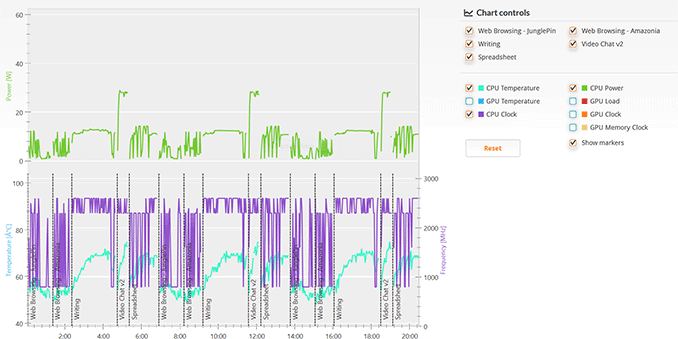
Surface Pro 2 PCMark 8 v2 Work Suite
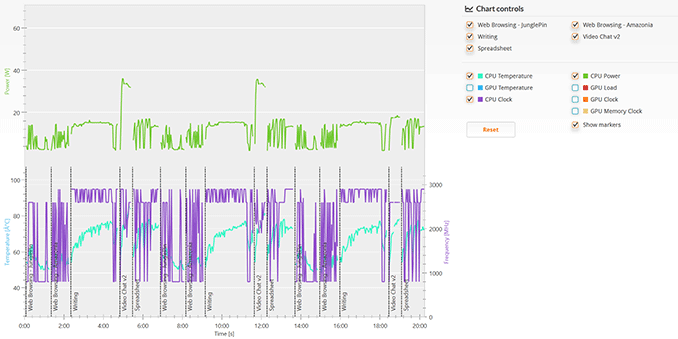
Surface Pro 3 PCMark 8 v2 Work Suite
Both devices do a good job of reaching max turbo fairly regularly, but Surface Pro 2 appears to spend more time at its max turbo state. By the last loop of the benchmark Surface Pro 3's max power is limited (green line) by the time we get to the video chat workload, I suspect that is where we lose a bit of performance. I'm only looking at the last of three suite runs here, if we looked at the second one the results would be even worse.
I haven't tested Surface Pro 3 in Microsoft's new docking station so I don't know if the device changes its thermal profile at all when docked, but in tablet or laptop mode it's definitely going to throttle quicker than Surface Pro 2 did. I must stress that I don't think this is necessarily a bad idea. Surface Pro 3 improves usability over Surface Pro 2 by leaps and bounds, and it's still faster under load than the original Surface Pro. All of this comes at the expense of reduced sustained performance. As you'll see from the rest of our tests, peak performance did get better over last year's model.
Fan Noise
Surface Pro 3's single fan is more noticeable than in Surface Pro 2. The sound it produces isn't necessarily louder, and when spinning it sounds a lot like any other Ultrabook with a fan in it. Compared to Surface Pro 2, the fan does kick in more frequently. For light tablet workloads or even light office work on Surface Pro 3, the fan remains silent. It's only when you're doing anything CPU or GPU intensive that you'll hear it spin up. The big difference is that in situations where you wouldn't hear fans spinning on Surface Pro 2, you'll sometimes hear it on SP3. This is the tradeoff that comes with the thinner chassis.










274 Comments
View All Comments
ymcpa - Monday, June 23, 2014 - link
A decent laptop is $500-$600. A decent 10" tablet is around $400. Those two devices will cost about the same as the surface. Each of those devices will perform a little better than the surface is certain tasks, but you have to carry both of those devices with you to get the same functionality as the surface. The MacBook air (don't know why you mentioned the MacBook pro which is much more expensive) has the better keyboard but can't really do any tasks that the surface can't. Same with the Ipad Air. It is lighter and has a longer battery life, but can't perform any task that the surface can't. However, you will need both those devices to perform the same task as a single surface.basroil - Tuesday, June 24, 2014 - link
Where the hell can you find a decent laptop for $600? The cheapest ones on newegg are about $800!ymcpa - Tuesday, June 24, 2014 - link
depends what your definition of decent is. The newegg list of most popular laptops has plenty of laptops in the $500's and $600's. They will probably meet the needs of many people. I used that price range because a person arguing that the surface is too expensive would most likely buy a budget laptop.basroil - Thursday, June 26, 2014 - link
"I used that price range because a person arguing that the surface is too expensive would most likely buy a budget laptop. "That has to be a joke? Microsoft is selling a premium product and makes no effort to hide it. "People say it's too expensive and instead buy a budget laptop" is not a valid response, since a decent laptop WITH THE SAME SPECIFICATIONS (other than screen of course) generally runs you just as much. Pentium, Celeron, and AMD chips are NOT decent laptop components, they are budget garbage for people who don't understand the difference.
joaoasousa - Tuesday, June 24, 2014 - link
The Surface is competing in the top end with it's high build quality and thinness, you can't compare it to plastic 600$ laptops. You must put it against similar products like the Macbook Air, Zenbook, etc.mkozakewich - Monday, June 30, 2014 - link
The Air has a better trackpad, but I wouldn't say it has a better keyboard. Different people like different things, and the Surface family has my favourite keyboard ever. I was using an HP Mini netbook in 2010 which was my previous favourite, and had a similar keyboard.Honestly, those big mechanical things just required too much horizontal and vertical travel and were annoying to use.
You're welcome to like the keyboards you like, and maybe get one of those Cherry MX mechanical keyboards, or stick with the one on the Air, but that doesn't mean something is 'better', only that it's more suited to you.
(Think of what one of those mechanical-switch people would say about the keyboard on the Macbook Air.)
PaulC543 - Tuesday, June 24, 2014 - link
Did *you* read the article, or did you just see a headline that mentioned the Surface and felt you had to criticize it?What bases does it cover? Let's see:
Media consumption tablet, check.
Light productivity work while mobile, check.
Heavy productivity work while docked, check.
Light to medium gaming, if that's your thing, check.
Single device that can handle tablet and laptop tasks, check.
In fact, this would probably be easier if you name a base the Surface *doesn't* cover, and make sure whatever you mention are tasks appropriate for notebooks/tablets. As far as I can tell, the only things you can bring up are:
Heavy mobile text entry (but put it in a dock with a desktop keyboard and mouse and it's as good as any desktop/notebook)
High-end gaming.
Latest and "greatest" "apps".
That's really about it.
As for a lower cost option, you *are* aware that Dell, Lenovo, Acer and the like are building $200-$300 Intel Atom based full Windows 8 tablets, aren't you? There's your Windows tablet entry device. Niche product? Literally everyone who's seen my Surface Pro 2 has said it's the device they want as their "mass market" iPad has proven so useless that it just sits on a shelf.
TEAMSWITCHER - Tuesday, June 24, 2014 - link
I would dispute your "Heavy Productivity While Docked" claim. Merely docking the Surface doesn't automatically give it a quad core processor with discrete graphics. So what does that leave? A single device that could serve as a Tablet or Notebook suitable for media consumption, light productivity, and lite gaming...all for the not so low price of $1177+tax (with keyboard and Pen)If your needs are humble I can see the Surface Pro 3 working well, but there are devices costing hundreds less that could do the same. I know many people who's PC's are now e-waste - an iPad and iPhone are their only devices. But for an enthusiast or power user the Surface Pro 3 will always be a secondary device to a more capable computer.
PaulC543 - Tuesday, June 24, 2014 - link
"I would dispute your...."Is your dispute based on hands-on experience? Because mine is. I attach mine to my 30 inch monitor and desktop keyboard/mouse, and it easily handles 3D modeling and Photoshop work. Certainly not to the level of my workstations, but when they're tied up rendering, the Surface easily fills in.
And this is why I said to make sure the tasks you mention are appropriate - of course it's not going to offer workstation-level performance, but no ultrabook class laptop will either.
As for the price, this has been beaten to death. The Surface is entirely in-line with ultrabook-class laptops, offers key features they typically don't (touch screen, pen input, etc.) and is able to serve as a straight tablet. Add the price of a laptop AND a tablet, and you're going to spend more and have to carry at least several times the weight/bulk of the Surface.
Everything you're written speaks quite loudly to the fact that you don't see the value in what the Surface offers and have never used one. Why, then, are you compelled to criticize a device which you clearly don't understand or would ever purchase?
TEAMSWITCHER - Tuesday, June 24, 2014 - link
I never said I didn't see value in it. I think it's a great device along the lines of other great machines like Apple's entire MacBook line and Lenovo's ThinkPad Carbon X1 Touch and Yoga 2.But your claims are just ridiculous... An iPad Air weighs only 1 pound..the iPad mini weighs much less. Adding a tablet to a notebook doesn't add "Several times the weight/bulk" it's not even 1-time the weight and bulk. Finally a two-in-one device isn't the same as having two devices. I can prop my iPad up next to my MacBook for a second screen. You can't do that trick with a Surface Pro 3, unless you carries another tablet with you.